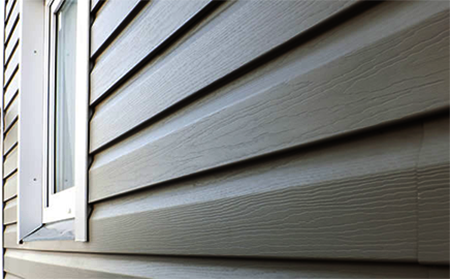Vinyl Siding
Vinyl siding is exterior siding for a house, made of plastic. It is used for weatherproofing and decoration. It is primarily manufactured from polyvinyl chloride (PVC). These vinyl siding are independently verified and certified to meet or go beyond the performance characteristics and quality standards and this is our assurance to you that the product you choose from us will help protect your home.
Why should you consider vinyl siding for your home? For homeowner’s, it means peace: from the expense and trouble of repainting the house every 5 years or so, or getting it done by paying someone. Vinyl siding costs about 11% less than cedar siding. Conservatives mock at the idea of covering houses, mostly older homes that have important architectural detailing, in "plastic." Other common doubts are that vinyl siding cannot hold its color without yellowing or fading, that it clasps in the summer heat and that, it can conceal serious complications with moistness in the walls. These concerns were worthy in the past. With huge advance in the materials and technology this is no longer the case.

Vinyl siding is manufactured by extrusion process. In this two layers of PVC, the top layer is durable and weatherable material which covers up to twenty-five percent of the siding thickness, are laid down in a continuous extrusion process. Depending upon the color, this capstock may include about ten percent of titanium dioxide, which is a pigment and offers resistance to cessation from ultraviolet rays. Like any other thing that is exposed to the sun, Vinyl siding will certainly fade over time, but the rate at which it fades is a lot slower than other claddings. The manufactures give a standard 50 years of warranty and some come with lifetime warranty. Insulated siding are more energy efficient as it warps your house in constant insulation.
Vinyl siding comes with varied color and design and thickness. Manufactures even have patterns like fish-scale shingles that are found on old homes. The vinyl siding have a smooth and textured panels and comes in vertical and horizontal configurations. The horizontal siding look good on traditional homes, while vertical siding fits well with contemporary styling. The thickness can vary within 1 manufacturer. Thicker products which is usually at higher price, are stiffer and add to the aesthetic look of the house.
Simply put, below are the reasons to consider vinyl siding:
Extreme Weather Conditions
All certified vinyl siding can withstand winds of 110 mph or higher, including extreme climate change. It can withstand subzero winters to hottest summers and is considered an all-weather option.
Color Fading
Vinyl siding comes with certification against color fading, which gives another level of assurance to our customers.
Rot & Decay
Fiber based products may crumble over time when moisture enters the plank whereas polymer based siding will not absorb moisture and their rain screening design do not hold water behind the siding. This ensures that walls are not damaged and hence could be the ideal choice.
